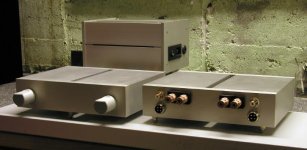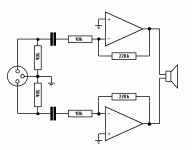Peter,
With the power supply I would say about $800 US. Assuming you are not using a distributor.
Jam
P.S. I just got an idea. You could offer a prize for the closest guess.
With the power supply I would say about $800 US. Assuming you are not using a distributor.
Jam
P.S. I just got an idea. You could offer a prize for the closest guess.

Oh common.. the Gaincard pulls $1500 a box (sans power supply), and its not even sexy looking. 🙂jam said:Peter,
With the power supply I would say about $800 US. Assuming you are not using a distributor.
Jam
P.S. I just got an idea. You could offer a prize for the closest guess.
--Jordan
It's hard to estimate the exact price because I was offered a trade. But your guess is quite close, although it should be closer to $1,000, I guess. And considering the effort involved, especially when this is still a prototype, it seems like a fair deal.
Peter Daniel said:I didn't want to give a customer a reason for a doubt if I used BG or not.😉
BTW, my acrylic GC has the caps skinned, but the first one also didn't and it sounded better.
So you remove a thin layer of plastic from the caps and then put the whole amp inside a block of........PLASTIC😱
could that be why it sounds bad

There are plastic and plastics. It's not that it sounds bad, it just doesn't have that extra touch. One way to get to know, is trying different things. What if it would sound better and I would've never tried it?😉 So don't blame me for that.
Here's another pic. Proper light and tripod makes also things look different.😉
Here's another pic. Proper light and tripod makes also things look different.😉
Attachments
Member
Joined 2002
Peter Daniel said:And that's my first finished GC. This one goes to Europe.😉
Peter,
I think you mentioned it before but don't know where. Any chance of telling me where to get them knobs you're using? I've been looking for something at my normal suppliers but have come up with nothing nice.
Really nice work otherwise. I just finshed the mechanics of my first GC pair in my workshop which consists of my kitchen table, fridge and any availably floor space. I've got aluminium shred in every carpet today. I see that the available tools make a difference in the end result (inidividual abilities matter too, to my disadvantage it seems). Really nice.
Bridge over trouble balance...
Hi there,
Very interesting thread indeed. And beautiful too, thanx to Peter 😉 .
I've read the thread all along, but something still puzzles me... Sorry if the question seems absolutely dumb, but If the GC is used in an "inverted" configuration, thus the amp is an inverter, I still don't understand why the "+" of the speaker is not connected to GND while the "-" is tied to the chip's output. This is done in the Zen design, but not here... Am I totally ?
?
Apart from this, I've had a little idea for combining balanced input and more power... As bridging means having two signals of opposite phases, why not trying to use both signals of a balanced line to drive two amps, and connect the speaker between the two outputs. I've attached a little drawing of the idea. Is it worth testing ? Feel free to flame or praise 😎 . Notice that I didn't mentionned the polarities of inputs and outputs, since I don't know the answer to my first question 😉
Cheers,
Hi there,
Very interesting thread indeed. And beautiful too, thanx to Peter 😉 .
I've read the thread all along, but something still puzzles me... Sorry if the question seems absolutely dumb, but If the GC is used in an "inverted" configuration, thus the amp is an inverter, I still don't understand why the "+" of the speaker is not connected to GND while the "-" is tied to the chip's output. This is done in the Zen design, but not here... Am I totally
 ?
?Apart from this, I've had a little idea for combining balanced input and more power... As bridging means having two signals of opposite phases, why not trying to use both signals of a balanced line to drive two amps, and connect the speaker between the two outputs. I've attached a little drawing of the idea. Is it worth testing ? Feel free to flame or praise 😎 . Notice that I didn't mentionned the polarities of inputs and outputs, since I don't know the answer to my first question 😉
Cheers,
Attachments
I have been meaning to try this from the first day I got my gc working, but I haven`t got to it yet...
My B&W`s would like that ekstra current!
My B&W`s would like that ekstra current!
Re: Bridge over trouble balance...
In the pictures it is not but it is of course up to everybody how they connect their speakers. Just like my Zen R I do connect the speaker in absolute phase on my GC. Why would one not? Lots of people are picky about absolute phase and want switches for phase on their pre-amps but in this particular thread it is often neglected. I did ask the same question as I felt it justified but the reply then was that there was no need to be anal about it. I just can't see any reason why one would not at least aim at correct phase as the work involved is nonexistent (solder 2 cables one way instead of the other way...). I say do it..
http://www.diyaudio.com/forums/showthread.php?postid=76588#post76588
CheffDeGaar said:Hi there,
Very interesting thread indeed. And beautiful too, thanx to Peter 😉 .
I've read the thread all along, but something still puzzles me... Sorry if the question seems absolutely dumb, but If the GC is used in an "inverted" configuration, thus the amp is an inverter, I still don't understand why the "+" of the speaker is not connected to GND while the "-" is tied to the chip's output. This is done in the Zen design, but not here... Am I totally?
question 😉
In the pictures it is not but it is of course up to everybody how they connect their speakers. Just like my Zen R I do connect the speaker in absolute phase on my GC. Why would one not? Lots of people are picky about absolute phase and want switches for phase on their pre-amps but in this particular thread it is often neglected. I did ask the same question as I felt it justified but the reply then was that there was no need to be anal about it. I just can't see any reason why one would not at least aim at correct phase as the work involved is nonexistent (solder 2 cables one way instead of the other way...). I say do it..
http://www.diyaudio.com/forums/showthread.php?postid=76588#post76588
Oups... Missed this one 
Thanks, UrSv.
Dan,
Just some delay needed, or are you experiencing design difficulties ? I hope it'll work... Tell us ASAP.

Thanks, UrSv.
Dan,
Just some delay needed, or are you experiencing design difficulties ? I hope it'll work... Tell us ASAP.
Cheff,
It is only a matter of time.
Since I have a working stereo version it`s just like Nike`s advertising; just to it...
Maybe this weekend? 😉
Dan.
It is only a matter of time.
Since I have a working stereo version it`s just like Nike`s advertising; just to it...
Maybe this weekend? 😉
Dan.
This is really interesting.
I want to buy LM3875. But don't know where to buy just that one here in Sweden. Any ideas Svedalaboys??
I can find the LM3886 for about 10$ here. But want to go with the other one.
Unless you advice me otherwise 😉
I think i'm gonna do the minimized gainclone from peter.
Been out of the buisness of diy amps for a while (A thousand other project running at the same time)
Thanks
/Patrik
I want to buy LM3875. But don't know where to buy just that one here in Sweden. Any ideas Svedalaboys??
I can find the LM3886 for about 10$ here. But want to go with the other one.
Unless you advice me otherwise 😉
I think i'm gonna do the minimized gainclone from peter.
Been out of the buisness of diy amps for a while (A thousand other project running at the same time)
Thanks
/Patrik
The knobs were bought surplus, locally. They come from older Classe preamps.
I was also thinking that amp should reverse phase, but checking with a scope, didn't show it.😉
I was also thinking that amp should reverse phase, but checking with a scope, didn't show it.😉
RS Components have them *all*. Only thing though is that you can only order items in stock if you're not a company. I use my dad's company for the ordering and then I just pick up the invoice and pay it which gives me full ordering possibilities.
The RS prices are also much better for these parts than for instance ELFA. LM3875T is SEK 75/USD 8 at qty 1 whereas ELFA is SEK 115/USD 14.
The RS prices are also much better for these parts than for instance ELFA. LM3875T is SEK 75/USD 8 at qty 1 whereas ELFA is SEK 115/USD 14.
Peter Daniel said:The knobs were bought surplus, locally. They come from older Classe preamps.
I was also thinking that amp should reverse phase, but checking with a scope, didn't show it.😉
Bummer, I like them knobs and as I said it is hard to find nice ones.
You mean that your output is the same phase as your input?
Turn-on/turn-off DC transient
Has anyone investigated using the gainclone as a tweeter amp in a bi-/tri-amp arrangement? I'm currently playing with one that is capacitor-coupled at the output, but due to the transient protection circuitry I am very tempted to run it direct-coupled.
The National datasheets do not provide any parameters for the protection circuit. I do not have access to a scope capable of measuring the turn on spike. Is there anyone who does?
Has anyone investigated using the gainclone as a tweeter amp in a bi-/tri-amp arrangement? I'm currently playing with one that is capacitor-coupled at the output, but due to the transient protection circuitry I am very tempted to run it direct-coupled.
The National datasheets do not provide any parameters for the protection circuit. I do not have access to a scope capable of measuring the turn on spike. Is there anyone who does?
The amp inverts phase indeed Peter, after all this topology is called an inverting amp. So reversing the speaker connections does make sense when one emphasises on absolute phase. It may come handy in case you use a non os DAC. Both devices invert and absolute phase will be correct again. This can possibly be a stimulation to build a Kusonoki style DAC  Just don't say it was me that made you do it !
Just don't say it was me that made you do it !
Jean-Paul
 Just don't say it was me that made you do it !
Just don't say it was me that made you do it !Jean-Paul

- Status
- Not open for further replies.
- Home
- Amplifiers
- Chip Amps
- This is not just another gainclone

